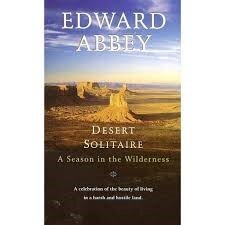Written by Dana Shiller
In honor of Earth Day, I thought I’d suggest some good reading from the wonderful world of environmental literature. Depending on why you read, you might find any one of these books great to curl up with on a cold spring evening with a cup of tea, or a perfect inspiration for your next trek. I’m going to give you one widely read classic, one cult classic, and a fairly new release from the UK that bridges the genres of environmental literature and the addiction/recovery memoir. If you enjoy these titles, I hope you’ll consider taking English 222 (Literature of the Environment) in Spring 2021!
Edward Abbey, Desert Solitaire (1968)
If you’re tired of raw spring weather and crave a desert escape, I highly recommend this environmental classic. Ed Abbey was born in Indiana, PA and after a series of odd jobs escaped to the desert Southwest, becoming a park ranger in what was then Arches National Monument in southern Utah. Abbey was a talented observer of the desert landscape; he was also a committed anarchist, and the vignettes that make up this book are simultaneously masterpieces of nature writing and bulletins from Abbey’s distinctively cranky world view. Among my favorite chapters: “The Serpents of Paradise,” in which he befriends the snakes that live under his trailer steps, and “Havasu,” about a solo hike in the Havasu Falls area of the Grand Canyon that goes terribly awry. But perhaps the most famous part of the book is his polemic against what he called “Industrial Tourism,” or the American public’s obsession with having easy automobile access to areas Abbey believed should remain inaccessible. In his polemic, he says “Let them take risks, for Godsake, let them get lost, stranded, drowned, eaten by bears, buried under avalanches—that is the right and privilege of any free American.” His firm conviction that the American wilderness should only be accessible to those on foot or horseback, and that indeed the point of wilderness is to be inaccessible, infuriated many (including his employer, the National Park Service) but set the stage for a philosophical battle that is still ongoing.

J.A. Baker, The Peregrine (1967)
A word of warning, before you grab yourself a copy of this book. The first time I taught it, one of my students noted that “nothing really happens in this book. I mean, other than the birds kill stuff, then they eat it.” This is, by the way, pretty much true. That said, this ornithological classic has passages of such crystalline beauty that it is entirely worth enduring all those descriptions of peregrine falcons stripping carcasses clean. J.A. Baker spent his entire life in Essex, on the southeast coast of England: a flat, marshy and generally unremarkable part of the country. He worked for the British automobile association, but never learned to drive; his hobby was riding his bike through the Essex countryside, tracking peregrine falcons, then in danger of extinction due to DDT. The book, which condenses ten years of meticulous peregrine observation into four seasons, details Baker’s obsession with these remarkable birds, which to him symbolized a profound wildness and otherness that he craved. “I have always longed to be a part of the outward life,” he writes, “to be out there at the edge of things, to let the human taint wash away in emptiness and silence as the fox sloughs his smell into the unworldliness of water; to return to the town as a stranger.” Whereas many writers whose subject is animals anthropomorphize, comparing their subjects to humans, Baker does the opposite: he is able to get so close to the falcons—to see what they see– because he wants to become a bird. In a typical passage, Baker notes that “For a bird, there are only two sorts of bird: their own sort, and those that are dangerous. No others exist. The rest are just harmless objects, like stones, or trees, or men when they are dead.” Highly recommended for anyone who turns to nature as a way of getting out of themselves.

Amy Liptrot, The Outrun (2016)
This memoir by a young British writer describes her return to Orkney, a remote island off the north coast of Scotland, after a decade of partying and heavy drinking in London. Raised on Orkney by homesteading parents (called “crofters” in Scotland), Liptrot cannot wait to leave the island, and yet it is the first place she thinks to go when her alcoholism becomes too debilitating to ignore: “It wasn’t cool to be crying at parties to anyone who would listen about how my boyfriend had left me because of my drinking while swigging from a bottle of beer in one hand and a glass of wine in the other.” Back on the family farm, Liptrot heals by watching whales and tagging along with seabird researchers on expeditions to islands now uninhabited, but with histories of human habitation dating back to the Iron Age. Her commitment to this wild, remote place becomes a crucial part of her commitment to her own sobriety, as if in excavating the history of these islands, and coming to know them intimately, she can retrieve a missing piece of herself. I particularly loved Liptrot’s description of seeing the Merry Dancers (the Scots name for the aurora borealis): “It’s brighter than a full moon and the birds, curlews and geese, are noisier than they usually are at this time of night, awakened by a false dawn. There is static in the air and it’s an unusual kind of light, the eerie glow of a floodlit stadium or a picnic eaten in car headlights.” Liptrot’s account of her addiction behaviors, as well as her desperate attempts at recovery, is as clear-eyed and unflinching as her descriptions of the natural world. Highly recommended for anyone who likes their nature writing with a dose of the “real world.”


